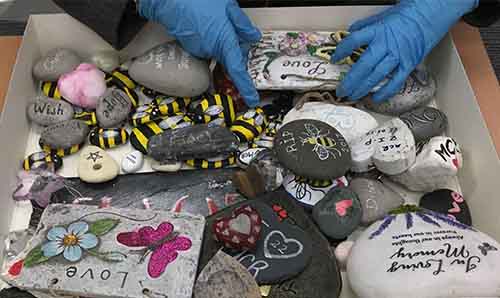Collecting and documenting spontaneous memorials
Author: Kostas Arvanitis (Art History and Cultural Practices)

This practice-based project examines the processes and decision-making involved in the formation and legacy of spontaneous memorials’ collections in museums, their impact on museum policy and practice, and their role in shaping people’s perceptions and memories of the original events. Spontaneous memorials are grassroots mourning practices that appear after tragic events, including terrorist attacks and natural disasters. Such an examination is significant, timely, and internationally relevant, because of the growing frequency of spontaneous memorialisation around the world, the role of museums in constructing personal and collective memories of the related events, and the challenges these spontaneous memorials pose to established museum practices. The research design follows a mixed-methods approach encompassing archival research, exhibition analysis, participant observation, semi-structured interviews, visitor research, auto-ethnography and documentary filmmaking on five UK and international case studies of spontaneous memorials after terrorist attacks: Manchester (2017), Barcelona (2017), Brussels (2016), Orlando (2016), and Paris (2015). Working with cultural organisations across the case studies, the project will inform collecting and documentation policy and practice in the UK and internationally, develop new approaches to the digitisation of archives of spontaneous memorials, and enhance cultural and professionals understanding of the role of collections of spontaneous memorials in post-attack community recovery.
Applying open research practices
In the case of the Manchester Arena bombing in 2017, the author co-designed with Manchester Art Gallery (MAG) a research project with the aim of capturing and analysing – both in real time and longitudinally – the process, agents, decision-making and impact of collecting, conserving, storing, using, digitizing and making accessible the spontaneous memorials that sprung up in the city after the attack. This included a six-month research residency by the author in MAG, which allowed him to be embedded in the structure and process of decision-making. Auto-ethnography, participant observation and co-production have been key aspects of the project’s research practice. This practice has allowed documenting critically and creatively the evolving thinking, interactions with different stakeholders and decision-making about the legacy of the spontaneous memorials, as well as the impact of those decisions on institutional life, policy and practice. It has also led to co-designing with MAG a documentation and public access strategy for the spontaneous memorial items. This open research practice has provided a blueprint practice-as-research and research-as-practice methodology for related cases in the UK and abroad.
Overcoming challenges
Spontaneous memorialisation occurs after unexpected violent events. This presents a number of practical, methodological and ethical challenges for researchers (and practitioners), especially when it comes to practice-based and co-produced research that involves documenting and co-developing cultural practices in real-time. This was the case with the Manchester Arena bombing. Overcoming or mitigating those challenges required and were benefited by rapid preparation of an ethical approval application and pre-existing collaboration with relevant cultural organisations.
Benefits of using these open research practices
The use of practice-based and co-produced research in studying the cultural practices around spontaneous memorialisation has led to the following benefits: the analysis and outcomes of the research are based on real-life practice; the societal impact of the research is embedded from the outset in the research design; cultural organisations and professionals are not just subjects, but partners in the collaborative research, which further ensures the relevance and applicability of the research outcomes.
Top tip
Practice-based and co-produced research, especially on research that requires rapid-response, is much benefited by drawing on established collaborations with relevant partners and by outlining the impact of the research from the outset.
